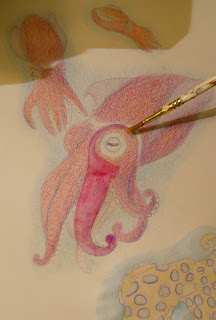As a painter and illustrator, I use many mediums to generate images. In recent months I've taken to using charcoal and exploring oil paints on canvas, both mediums are newer in my experience but very workable and preferable for being traditional.
 |
| Wolverine Study ▲Charcoal |
 |
| Wolverine Study ▲Digital painting in progress |
 |
| ▲ Biomorphic Abstraction from observation (an In-Class charcoal study, spring 2016). |
Watercolor and Digital
For some animal illustrations -especially for those intended for digital viewing or for print- I use a stylus to enhance realism. Preliminary sketches are worked up on trace paper and then the image is transferred and painted in watercolor and pencil (by working with trace paper I am able to free-hand and trace my own sketches, flipping them over horizontally to refine posture, anatomical symmetry, and composition). Sometimes the process is finished there, but if I feel that the piece needs more detail work and enhancement of color, texture, and lighting, I will paint the rest on the tablet. Its a three-step process not so dissimilar to the methods used by other natural history artists who paint with graphics tablets, and it is definitely a useful skill when traveling.
 |
| Preliminary Sketch ▲Trace paper |
 |
| Watercolor Pencils Once the image is transferred over to paper and lightly drawn out in pencil I begin to distribute the colors of the painting with layers of watercolor pencil. I like the unique quality that is imparted with an image in watercolor and it is definitely a compatible medium when painting sea life. |
 |
| ▲ Wacom Techniques like pointillism are applied when painting with a graphics tablet. In this particular illustration, pointillism imparts realistic speckles in the mantles of the Purple Stubby Squid and the Blue-Ringed Octopus. Painting in Adobe Photoshop still involves an enhanced understanding of layers, and many of the same principals and techniques are applied when painting in other mediums. |
 |
| ▲ Denizens of the Pacific The finished illustration, a portrait of the Purple Stubby Squid (Rossia pacifica) and the poisonous Blue-Ringed Octopus (Hapalochlaena sp.). |
 |
| Sketching The Clown Triggerfish (Balistoides conspicillum) on illustration board with white charcoal.Using a 'Shammy' or chamois cloth thoroughly erases lines created with vine charcoal and so it is very easy to lightly and loosely sketch out forms and merely erase and redraw lines. |
 |
| Early layers of the Orange-Lined Triggerfish (Balistapus undulatus) in acrylic. |
 |
| Mahi-Mahi (Coryphaena hippurus), digital. |
 |
| Profile of the Amazon River Dolphin (Inia geoffrensis). |
Multimedia Still Life
Still lifes are not normally my specialty, but for the painting course I'm taking this semester our subjects are squashes and pumpkins. This piece is getting blocked in with acrylic but will be finished in oil paints in effort to achieve the highest photorealistic effect (more photos soon!).
 |
In-Class Still Life Study of autumn harvest. In these first few stages of the painting, a light blue wash is added and the shapes are blocked in with acrylic. The initial under-layers of this study will be in acrylic, but I will finish off the realism in oil paint.
|
 |
| Many color washes are involved. |
Bright, Michael., Dolphins. New York: DK Publishing, 2001.
Folkens, Peter., Guide to Marine Mammals of the World. University of California: AA Knopf, 2002.
Randall, John E., Shore Fishes of Hawai'i. Hawai'i: University of Hawai'i Press, 1996.
Hoover, John P., Hawaii's Fishes: A Guide for Snorklers Divers and Aquarists. Korea: Mutual Publishing, 1993.
Goodson, Gar., The Many-Splendored Fishes of Hawaii. Hong Kong: Stanford University Press, 1985.
Cooper, Alan., Fishes of the World. New York: Bantam Books, 1971.

















